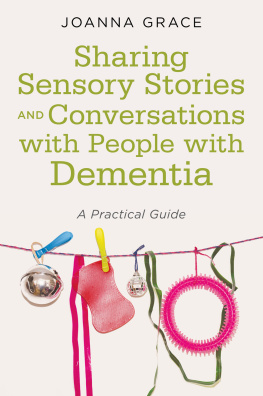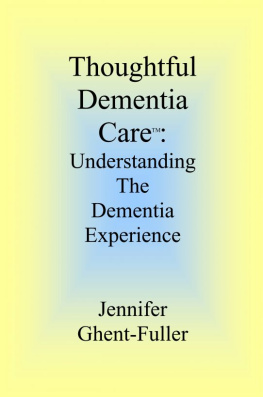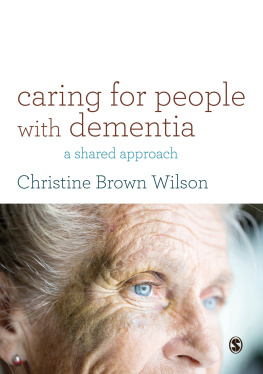Champagne Tina - Sensory Modulation in Dementia Care
Here you can read online Champagne Tina - Sensory Modulation in Dementia Care full text of the book (entire story) in english for free. Download pdf and epub, get meaning, cover and reviews about this ebook. publisher: Jessica Kingsley Publishers, genre: Romance novel. Description of the work, (preface) as well as reviews are available. Best literature library LitArk.com created for fans of good reading and offers a wide selection of genres:
Romance novel
Science fiction
Adventure
Detective
Science
History
Home and family
Prose
Art
Politics
Computer
Non-fiction
Religion
Business
Children
Humor
Choose a favorite category and find really read worthwhile books. Enjoy immersion in the world of imagination, feel the emotions of the characters or learn something new for yourself, make an fascinating discovery.

- Book:Sensory Modulation in Dementia Care
- Author:
- Publisher:Jessica Kingsley Publishers
- Genre:
- Rating:5 / 5
- Favourites:Add to favourites
- Your mark:
- 100
- 1
- 2
- 3
- 4
- 5
Sensory Modulation in Dementia Care: summary, description and annotation
We offer to read an annotation, description, summary or preface (depends on what the author of the book "Sensory Modulation in Dementia Care" wrote himself). If you haven't found the necessary information about the book — write in the comments, we will try to find it.
Sensory Modulation in Dementia Care — read online for free the complete book (whole text) full work
Below is the text of the book, divided by pages. System saving the place of the last page read, allows you to conveniently read the book "Sensory Modulation in Dementia Care" online for free, without having to search again every time where you left off. Put a bookmark, and you can go to the page where you finished reading at any time.
Font size:
Interval:
Bookmark:

of related interest
Adaptive Interaction and Dementia
How to Communicate without Speech
Dr Maggie Ellis and Professor Arlene Astell
Illustrations by Suzanne Scott
ISBN 978 1 78592 197 1
eISBN 978 1 78450 471 7
Visiting the Memory Caf and other Dementia Care Activities
Evidence-based Interventions for Care Homes
Edited by Caroline Baker and Jason Corrigan-Charlesworth
Foreword by Dr G. Allen Power
ISBN 978 1 78592 252 7
eISBN 978 1 78450 535 6
Embracing Touch in Dementia Care
A Person-centred Approach to Touch and Relationships
Luke Tanner
ISBN 978 1 78592 109 4
ISBN 978 1 78450 373 4
Sensory Modulation in Dementia Care
Assessment and Activities for Sensory-Enriched Care
Tina Champagne

The information provided is a general guide only. Refer to the medical, nursing, occupational and physical therapy members of the treatment team for decisions related to the care of each individual. The information provided in these guidelines is based on the available best practice literature, or in the absence of this literature, expert opinion.
First published in 2018
by Jessica Kingsley Publishers
73 Collier Street
London N1 9BE, UK
and
400 Market Street, Suite 400
Philadelphia, PA 19106, USA
www.jkp.com
Copyright Tina Champagne 2018
Front cover image source: iStockphoto. The cover image is for illustrative purposes only, and any person featuring is a model.
All rights reserved. No part of this publication may be reproduced in any material form (including photocopying, storing in any medium by electronic means or transmitting) without the written permission of the copyright owner except in accordance with the provisions of the law or under terms of a licence issued in the UK by the Copyright Licensing Agency Ltd. www.cla.co.uk or in overseas territories by the relevant reproduction rights organisation; for details, see www.ifrro.org. Applications for the copyright owners written permission to reproduce any part of this publication should be addressed to the publisher.
Warning: The doing of an unauthorised act in relation to a copyright work may result in both a civil claim for damages and criminal prosecution.
Library of Congress Cataloging in Publication Data
A CIP catalog record for this book is available from the Library of Congress
British Library Cataloguing in Publication Data
A CIP catalogue record for this book is available from the British Library
ISBN 978 1 78592 733 1
eISBN 978 1 78450 427 4
Printed and bound in Great Britain
The appendices can be downloaded at www.jkp.com/catalogue/book/9781785927331 for personal use with this program, but may not be reproduced for any other purposes without the permission of the publisher.
In honor of my grandmother, who had dementia in the later years of her life. Her experiences inspired me to adapt the Sensory Modulation Program more specifically to working with people with dementia. She enjoyed many of the strategies proposed in this book. She also instilled in me the importance of helping others and of having a sense of humor, and always encouraged me to go after my dreams.
Contents
To my children, I am deeply grateful to you for your love and ongoing support. To Kristina Tams, thank you for helping with the editing of this book. To my mentors and colleagues, thank you for supporting my ideas and projects over the years; it has been wonderful to collaborate with all of you about how important it is to address sensory integration and processing, as part of occupational therapy and other therapeutic services, with different populations and in various settings. To those of you who have worked with me with this specific population (people with dementia), it has been an honor to work together to develop and implement approaches that have helped to demonstrate the value of a more humane, nurturing, compassionate, and sensory-based approachthank you!
Thank you also to Karen Poole, TFH USA (www.tfhusa.com) and Lisa Compton (www.SensoryCraver.com) for granting permission to use the product photographs in this book.
Tina Champagne, OTD, OTR/L, FAOTA, is the Executive Director of Cutchins Programs for Children and Families in Northampton, Massachusetts. She is also the director of and primary consultant for Champagne Conferences and Consultation, and a professor for the American International Colleges doctoral program in occupational therapy.
Dr. Champagne is an occupational therapist and her primary areas of interest include: organizational change, trauma and attachment informed care, the applicability of individualized, sensory-based approaches across the lifespan, mental health, wellness, and quality of life. She has published a variety of books, book chapters, articles, resource documents, and research studies.
Dr. Champagne is also a reviewer for several peer-reviewed journals and the creator of the Sensory Modulation Program. Dr. Champagne has received numerous awards and is highly recognized for her work, particularly in its application across a broad variety of practice settings and age ranges.
Given the significant advancements in the field of neuroscience, it is now widely recognized that the different sensory-rich experiences human beings encounter every day help to nourish the nervous system (Ayres ). Each of the sensory systems has specialized receptors that detect very specific types of sensory stimuli. The sensory input received by the receptors is sent to the brain, and helps to support the ability to feel safe and self-regulated, and to functionally engage in meaningful roles, routines, and activities. The eyes detect and track visual and spatial input, the ears pick up on sounds, the nose takes in the air we breathe and different types of chemicals known to us as scents, and the skin contains a variety of tactile receptors that help us understand the many different types of touch sensation experienced (e.g., light touch pressure, deep touch pressure, temperature, vibration, pain). The mouth is used to taste, eat, and drink, and also to breathe, speak, sing, and even play an instrument!
In addition to the five basic sensory systems (tactile, vision, auditory, olfaction [smell], and gustatory [taste]), there are a few others that people rarely know about. These sensory systems are the vestibular, proprioceptive, and interoceptive systems. The vestibular system supports the ability to overcome gravity, coordinate the body, and safely navigate the world. Muscles are also major sensory organs and the proprioceptive receptors are located in the muscles, joints, tendons, and connective tissues of the body. The proprioceptive receptors are activated when a person engages in activities against resistance, stretching, or other movement-based actions. Proprioceptive input contributes to the ability to know where the body is in space and time from a body-based felt sense. The vestibular and proprioceptive systems work together with other sensory systems to support body awareness, equilibrium, and the ability to sequence the body through the different steps of activities. Interoception is the ability to be aware of ones different internal states (e.g., degrees of alertness, illness, hunger, digestion).
The processing and organization of all sensory and motor input is part of the role of the central nervous system across the lifespan. The way an individual processes and organizes sensory input contributes to the formation of ones self-perception, the perception of others, and the physical environment. Different types and intensities of sensory and motor stimuli influence whether or not a person feels safe, regulated, and able to functionally communicate and engage in activities. In fact, without enough sensory input throughout each day sensory deprivation occurs, making it difficult for human beings to remain resilient and able to gain or maintain skills, such as strength, agility, and the ability to pay attention. The sensory systems also play a protective role, by sending signals to the brain that help to alert individuals to potential safety concerns.
Font size:
Interval:
Bookmark:
Similar books «Sensory Modulation in Dementia Care»
Look at similar books to Sensory Modulation in Dementia Care. We have selected literature similar in name and meaning in the hope of providing readers with more options to find new, interesting, not yet read works.
Discussion, reviews of the book Sensory Modulation in Dementia Care and just readers' own opinions. Leave your comments, write what you think about the work, its meaning or the main characters. Specify what exactly you liked and what you didn't like, and why you think so.









